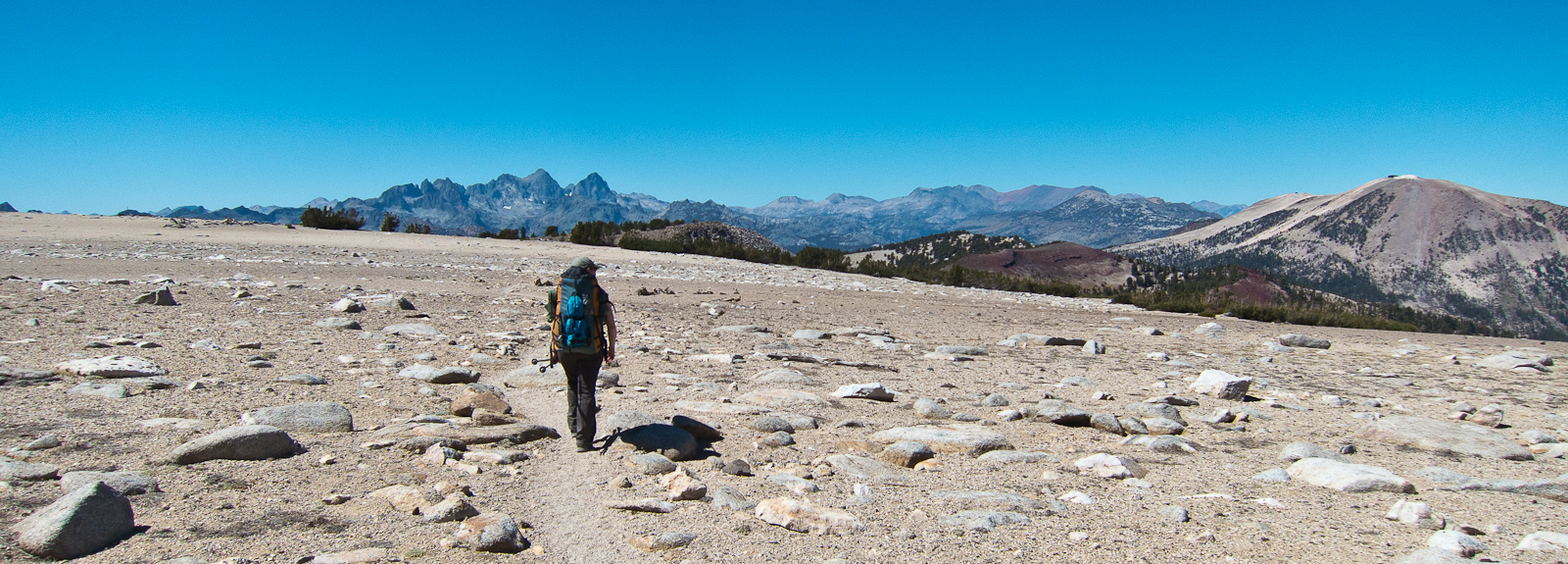words by Becky and Pete
We hiked the John Muir Trail from
Yosemite to Mt.Whitney in the late summer of 2010. The trip was nothing
short of amazing- the scenery, the physical challenge, the whole trip was
filled with a sense of wonder and is easily one of the top backcountry trips
we’ve done. Since that time, we’ve both wanted to return to the Sierras
for another long hike, but knew there was much more to see than just repeating
the Muir Trail.
We don’t remember when exactly,
but sometime after hiking the JMT, we read about the Sierra High Route (SHR).
The SHR is an alternative route travelling the spine of the Sierras developed
by climber and hiker Steve Roper. Steve produced a guidebook describing the 200
mile route that is only about half on-trail and shares just a few miles with
the JMT. It also spends much more time in the alpine, rather than climbing to a
pass only to descend to another valley. It sounded like a rather challenging,
and definitely scenic long distance trip.
We set our sights on late summer
2014, and we decided that in the span of two weeks, we could probably cover
about half of the SHR’s full distance. Some of the off-trail sections are miles
of scree, talus, and boulder hopping with some occasional scrambling and there
was no way we could average 17 miles a day like we had on the JMT. One of the
most hazardous off-trail sections, Snow Tongue Pass, was between the Evolution
Valley and Desolation Basin, so if we started north of there, we should have a
fairly reasonable 100 miles to cover in two weeks from Bishop to Tuolumne
Meadows. An added bonus was that because the area we’d be starting in was
Wilderness Area, and not National Park, our friends Andy & Mica could
join us with their dog Tundra (dog’s aren’t allowed on trails in National
Parks).
Our gear was largely the same as
what we’d used on the JMT. A few add-ons this time included dust gaitors for
our low-top shoes to keep pebbles and scree out, thin fleece pullovers to
supplement our down jackets, and Pete included a lightweight Montbell sleeping
bag cover to add some warmth to his 1-lb Vireo sleeping bag. For the JMT, we
carried our EPIRB emergency beacon, but for this trip we also carried a GPS,
and a small NOAA weather radio.
Pre-trip
Unlike the JMT, the logistics for
the SHR were pretty easy, thanks to our friends who were all vacationing on the
east side of the Sierras at the same time. Andy and Mica would join us at the
North Lake trailhead and hike in with us, then we’d part company on day 2, and
they’d return to the cars. On the way home, they’d drive their van, and our car
over Tioga Pass and leave our car at the Tuolumne Meadows trailhead for us….no
need for complicated bus shuttles or rental cars this time! Thanks Andy and
Mica!!
We started our trip with a stop
in Salem to attend a memorial service for Pete’s beloved grandfather Harry. He
was an amazing, inspiring man who helped shape Pete’s love of the outdoors. It
was a nice opportunity to visit with family and remember all the great things
Harry contributed to the lives of every person he met.
We left Salem on Saturday and
drove to Susanville. We stopped there because it was roughly half way to
Mammoth and because they have a brewery, Lassen Ale Works. This interest in
local breweries would drive many of our future decisions about where to stop
along the way. We had a smoky porter and a full-bodied, sweet brown ale - both
very tasty!
The next day we continued the
somewhat boring drive through eastern northern California and Nevada until we
got to the turnoff for Bodie, an abandoned mining town turned state park. Much
of the 19th century town has been preserved exactly as it was left back in its
heyday, complete with plates set on tables collecting years of dust. After
visiting the cemetery and getting depressed by the number of children buried
there we decided to head back up the very rutted road to highway 395 and
continue our trek to Mammoth.
We met up with Marcus, Anastasia,
Andy and Mica in Mammoth Lakes where we learned that Andy and Mica’s VW
Westfalia van, Sully, had begun leaking gas. They needed to get it looked at in
the morning down in Bishop. Originally they were going to join us for the first
five days of the trip, but we realized that this would probably change that.
We met them down in
Bishop where their van had been fixed (yay!), but we were short on time to set
up the needed car shuttle for the five day trip and they were a little gunshy
to leave it at the trailhead for five days so after considering several
different options, they decided to hike in with us for the first night and then
hike out the next day. They had to drive back to Mammoth to collect some gear
they’d left with Marcus and Anastasia, but eventually we all picked up our
permits, made the mandatory stop at Schatt’s Bakery for breakfast pastries for
the following morning and made our way to the North Lake Campground high above
the hot, arid slopes of the eastern Sierra.
link to photo album




















